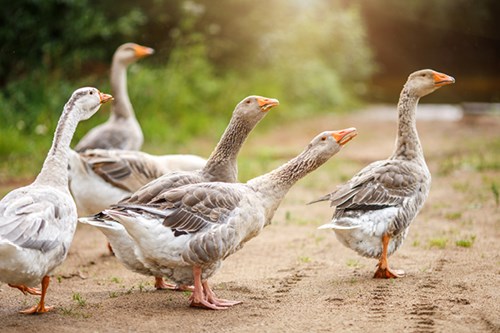Gapeworm (Syngamus trachea and Cyathostoma bronchialis) in Poultry

There are two sorts of these tracheal worms that both go by the common name of gapeworm.
Infections of land birds are usually due to Syngamus trachea and those in waterbirds, primarily ducks, geese, and swans, are usually due to Cyathostoma bronchialis. However, both genera infect a variety of species, including both land and waterbirds. Infections with S. trachea have been more extensively studied than infections with Cyathostoma sp. because of its previous importance as a disease-causing parasite of poultry.

Gapeworm (Syngamus trachea)
Is a particular problem in land based birds; pheasant and turkey poults. They are a bright red Y-shaped worms 1-2cm long that migrate through lungs and attach to the tracheal mucosa, causing laboured breathing and 'gaping‘. Severe infections can obstruct the trachea causing suffocation. Infective larvae can live for 4 years in intermediate hosts such as slugs, snails or earthworms. Wild birds, especially rooks and blackbirds, are a common source of infection. Worm eggs are coughed up, swallowed and passed on in dung.
Gapeworm (Cyathostoma bronchialis)
Both ducks and geese can get gizzard worm but geese are far more likely to suffer from its effects and die. Indeed it is one of the most common parasites to infect geese with goslings much more affected than adults showing characteristic gaping symptoms. This is a very similar parasite to Syngamus trachea but much less studied. It also has an intermediate host, an earthworm as a vector.
Symptoms
Gapeworm infestations block an affected bird’s trachea with worms and mucus that causes it to cough, wheeze and breathe with its mouth open. The bird stretches its neck and gasps, making a hissing sound. Birds catch gapeworm by accidentally eating worm eggs from found in the ground or on earthworms, ground snails or slugs infested by gapeworm larvae. Once the eggs are in the bird’s system, they hatch and larvae migrate to the bird’s respiratory tract, where they establish themselves in the bird's trachea and become egg laying. This is when the gaping action begins. Young birds are more susceptible than older ones and are much more likely to die from heavy gapeworm infestations. Older birds can adapt and might show minimal symptoms such as an occasional cough or even no obvious clinical signs especially if they aren’t heavily infested with worms.
Look out for laboured breathing, gaping, coughing, weakness, emaciation and head shaking.
DETECTION & Treatment
A few other diseases, such as pneumonia, also make birds gape, so if you think your birds may have gapeworm a worm egg count is a useful diagnostic tool. Flubenvet is a licenced treatment for gapeworm but, as treatment is given as a total feed replacement, it can be particularly tricky to get grazers like geese to take sufficient for their body weight. Alternatives are available from your vet. Treatments that kill the worms in infected birds can result in dead parasites being inhaled, leading to fatal pneumonia.
Birds are unlikely to suffer from gizzard worm if treated when new to the premises and then fed well, or grazed at a low stocking density. It’s hard to prevent gapeworm because free-range birds have constant access to potentially infected earthworms, snails and slugs. The alternative is to raise your birds in sand, gravel or concrete floored pens and keep them away from bare or muddy ground whenever you can.